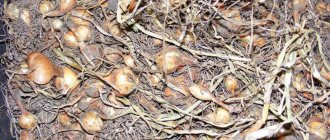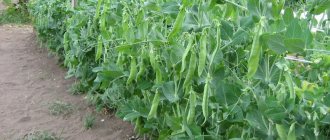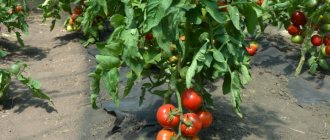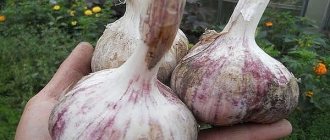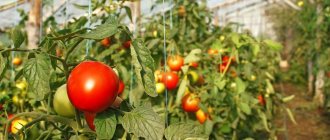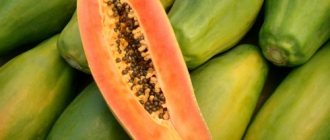Features of vegetable crops
Radish is an annual plant; according to its biological classification, it belongs to the Radish genus, which, in turn, belongs to the Brassica family. All parts of the plant are edible: root vegetables are used in salads, leaves are used for soups
Even if you plan to eat only the fruits, the green tops will also need to be given attention when growing radishes in a greenhouse
Photosynthesis occurs in the leaves of plants (the absorption of carbon dioxide from the environment and its transformation into useful substances necessary for development), so their condition directly affects the formation of the underground part.
Radishes are rich in vitamins B1, A and C, they contain iron, potassium and phosphorus
Planting radishes in autumn
The main point of planting radishes in the fall is the possibility of obtaining a harvest in the spring as early as possible, which is especially evident when planting a vegetable before winter in an unheated greenhouse. But at the same time you have to take some risks.
Did you know? The well-known characteristic of radishes, according to which they are red on the outside and white on the inside, is only partly true. In fact, it also comes in white-red, pink, yellow, purple and even pure white.
Advantages
- The advantages of this agricultural technology for growing root crops are:
- very early ripening of the crop;
- acquiring vegetable resistance to cold, diseases and pests;
- natural stratification to which seeds undergo wintering, as a result of which the strongest specimens survive and produce the best harvest;
- protection from the main pest of radishes - the cruciferous flea beetle, which wakes up after the winter radishes ripen.
Flaws
- The disadvantages of this agricultural technique for growing vegetables are:
- the possibility of making a mistake with the timing of sowing, which directly affects the success of growing winter radishes;
- the danger of seeds freezing in the soil during an excessively cold winter.
Varieties and growing conditions
Growing various vegetables for sale is an effective business option. At the same time, it is worth knowing how and when to plant radishes in a greenhouse, if this root crop is the main product. This plant is quite unpretentious and does not require special attention. Timely care, compliance with basic growing rules and choosing the right variety - these important points will ensure a good harvest and allow you to harvest radishes in winter for sale.
Many varieties of radish are distinguished by rapid germination, rich fruiting and good taste characteristics. Effective cultivation of any varieties in a greenhouse in spring, autumn or winter for sale is based precisely on these properties of a given plant
At the same time, it is important to choose a radish variety for the greenhouse, because each type of root crop has certain properties. Another important point is the organization and preparation of the greenhouse.
All varieties of radishes are divided into several types depending on their characteristics. The most early and medium-ripening types of crops are suitable for growing in a greenhouse in winter for sale. Options that have a ripening period of more than 40 days are best planted in spring. When choosing, you should also take into account the characteristics of the plants and the necessary conditions. The most disease-resistant varieties are “Camelot”, “Mokhovsky”, “Zarya”, “Rubin”, “Zhara”. In any case, it is necessary to grow radishes at the optimal temperature and in compliance with the rules of care for root crops. Radishes can be grown effectively in a greenhouse throughout the year. The resulting harvest may be intended for sale, but in any case, optimal conditions should be created in which the root crop will develop quickly and efficiently. The main important points are:
All radish seeds are divided into several types, which have certain characteristics. For example, hybrid seeds can be planted directly into the ground, as they are treated against diseases and infections. This option is optimal for dry sowing and growing in a greenhouse in winter. A more careful approach and selection require varietal seeds that you can collect yourself. Such elements need treatment, which reduces the risk of radish diseases in the spring and throughout the entire growing period in the greenhouse.
Encrusted seeds are plant grains that have a special shell that provides good stimulation of crop growth. Such material can be used for radishes in a greenhouse in winter for sale. The best option is pelleted seeds, the shell of which is a peat-mineral mixture. This material does not require preliminary preparation or careful processing.
To obtain a rich and high-quality radish harvest, it is worth treating simple seeds. The process ensures disinfection of elements, stimulation of their growth and development. To do this, you can place the seeds in a weak solution of potassium permanganate or use one immunocytophyte tablet per 100 ml of clean water. The seeds should be kept in the solution for about 12 hours. You can also place the planting material for a day in a solution of one large spoon of wood ash in 100 ml of water.
Sowing methods or how to plant radishes correctly
It is necessary to follow simple rules in order to get friendly shoots. Planting radishes in a greenhouse is done by placing the seeds in furrows at equal distances. The depth of planting affects the shape of the formed radish. If sowed very deeply, the root crops turn out to be elongated; if sowed too shallow, the seeds may dry out, fail to germinate, and a superficial root system is formed, which provides little nutrients to the plant. The optimal seed sowing depth is 1-1.5 cm.
- Manual sowing
The most painstaking, but also the most reliable way of sowing radish seeds. It is used for small garden areas, up to 10 square meters. First, make a furrow 1-2 cm deep in the garden bed. Dry or soaked seeds are used. Take one seed at a time with your hands, gently pressing it between your thumb and forefinger, and place it in the groove. The seeds have rather delicate coverings, so they cannot be squeezed or rubbed too much in your hands; if they are damaged, they lose their viability and die. The distance between the seeds depends on the varietal size of the root crop and ranges from 4 to 10 cm. For the convenience of measuring the same distance, you can use a matchbox with a side length of 5 cm. Having laid the seeds on the bottom of the groove, they are carefully sprinkled with earth, preventing displacement. Then compact the soil from above with a light roller or wide board to improve seed-to-soil contact without over-compacting. After sowing, abundant watering is required until puddles begin to form, but do not overwater, as the seeds may float to the surface.
- Sowing with a seeder
If the bed for radishes is more than 10 square meters, then it is better to use a mechanical hand seeder.
There are various types of planters, including single-row, double-row, and belt. Their main task is to evenly distribute the seeds along the furrow. Planting radishes in a greenhouse with their help is possible only with dry seeds, since they are severely injured with this method. Before use, the seeder is adjusted to the optimal depth and seeding rate. They are usually driven by a wheel on the seeding unit. When sowing, it is necessary to control how the process occurs; to do this, dig up the soil and evaluate the uniformity and depth of sowing. If there is a deviation from the specified parameters, the seeder is reconfigured. The disadvantage of this method of sowing is the inability to correct an incorrectly sown bed, but with sufficient skill it is possible to sow a fairly large area in a short time.
- Sowing with ribbons
On quiet, long winter evenings, there is an opportunity to prepare for the fastest way to sow radishes in a greenhouse and stick the seeds on paper tapes. They should be 0.5 cm wide and 2-2.5 m long. Mark them with a pencil every 5 cm. Boil the paste from starch and water until creamy. Then, using it, the seeds are glued to the designated places on the tape. This is quite painstaking work, but it significantly speeds up sowing.
When the time comes to plant radishes, make grooves of the required depth and place prepared ribbons with seeds on the bottom. They are then sprinkled with soil, tamped down and watered. Water soaks the paste and paper and the seeds germinate freely, being at a precisely specified distance.
There are other ways to plant radishes (sowing seeds, mixing with paste and sowing through a bottle), but they do not provide uniform distribution of seeds and are not considered, because then it is necessary to thin out the seedlings.
Agricultural technology for growing radishes
General information. Radish varieties.
In order for this root vegetable to be regularly on your table, you need to make the right selection of varieties. In addition, you should sow seeds in several stages, if your garden plot allows it. Such agricultural technology will allow you to grow more than one good harvest throughout the warm season at your dacha.
Providing good conditions is not so difficult:
Root seedsLet's highlight a few more:
Beautiful and tasty root vegetables
.
- Before directly planting the seeds, they can be placed in a damp cloth so that they hatch, and in order to avoid infection of the seedlings with “dry rot”, the seeds are heated in 50 degree water for 20 minutes. This will also allow for earlier shoots.
- If we talk about temperature, then radishes are quite unpretentious to it.
- Untimely harvesting leads to the fact that the root crop becomes coarser and the tops go to the shoot
- You want to see a tasty juicy root vegetable on the table all summer long. This means that radishes need to be planted in several stages, starting in April, under the film, and ending in August. Once the first crop has good leaves, you can sow the second batch in another bed. Some vegetable growers grow radishes at intervals of a week and a half, which ensures uniform ripening of the crop.
Preparing the soil before planting
To prepare the working solution, add about 2 cups of fresh ash and approximately 50 g of laundry soap to a 10-liter bucket of water. Mix everything thoroughly. You can scoop up a shovel of ash and spread it over a bed of crops. For some time, insects will limit their harmful activities.
According to their early maturity, radishes are divided into several groups:
During the germination of seeds planted in the soil, the temperature should range from 16 to 18 degrees Celsius.Calibration is carried out as follows:“Corundum”;
When choosing planting material for greenhouses, pay attention to the characteristics of a particular species.
Preparing radish seeds for sowing
Thanks to this growing technology, you can harvest up to 10-15 harvests, which is up to 30 kg per square meter. And considering that radishes are not a cheap vegetable (in the spring its cost is highest), you can not only provide your family with vitamins, but also, if you want, earn some money to purchase seedlings of other vegetable crops.
At the stage of selecting high-quality seed, the seeds can be sifted through a sieve with small diameter holes (up to 3 mm). This way you can quickly select high-quality radish grains. At the next stage
Plant care
.
For sowing, the soil must be well moistened.
When growing radishes, it is best to use drip irrigation systems, since abundant watering after treatment against pests will wash away the protective composition.
Ultra-early ripening varieties (vegetation period 18...25 days). The varieties “18 days”, “Children’s F1”, “20 days” are very popular among vegetable growers.
Radish pests and their control
When the shoots begin to appear, provide ventilation to the room by lowering the temperature to 6-8 degrees. (see also the article How to make automatic ventilation of a greenhouse with your own hands)
take a sieve, the mesh size of which is two millimeters;
"Togul";
It should be:
We feel the true arrival of spring when the first radishes appear on markets and store shelves.
The seeds are treated with a solution of potassium permanganate and water
up to 3°C. But at temperatures above 25°C, the fruits begin to wither and become empty inside. The optimal temperature for growing radishes is considered to be 18–20°C.
Harvest and storage
Root vegetables are removed from the tops, rinsed, dried, packaged in bags, and placed on the bottom shelf of the refrigerator. It is better to choose environmentally friendly bags made of kraft paper, which does not interfere with the “breathing” of the crop. If plastic bags are chosen for storage, holes are made in them or opened slightly. Depending on the plant variety,
Seeds are sown dry
Radishes are harvested as they ripen in the required quantities. As a rule, freshly harvested radishes are immediately consumed. If you water the radishes in the evening and collect them in the morning, without removing the roots, but cut the tops at a distance of 2...4 cm from the fruit, then it can be successfully preserved for up to 7...8 days. Radishes must be placed in a cool room, best stored in the refrigerator.
ParnikiTeplicy.ru
Sowing radishes ↑
Now let's move on to choosing seeds. Success depends on the correct choice of variety, since not everyone is suitable for this purpose. Greenhouse (optimal for growing in spring, resistant to bolting), Zarya (stress-resistant variety), Zhara (ideal for early forcing), Saksa (early ripening, time from sowing to harvest is less than a month), Early Red (created for growing in winter greenhouses).
By selecting varieties of different ripening periods, you can extend the harvest
Radishes can be grown all year round if you have a heating system. Conditions in the middle zone make it possible to grow in winter, even if the greenhouse is not heated. To plant in the spring, already in March, in about 1-2 weeks, you need to put the greenhouse in order, clear the snow, if necessary, repair the frame and stretch the film. This will help the soil thaw faster. Once the top 3-5 cm of soil becomes soft, planting radishes is already possible. Those who have not prepared the beds in the fall will have to wait for complete thawing, apply fertilizer, dig, level, and then start sowing.
Seeds are calibrated before planting.
To grow good quality radishes from seeds, they should be sifted through a 2 mm sieve before sowing. This will allow you to select the best planting material. It is useful to treat the seeds with potassium permanganate to reduce the likelihood of diseases. Sowing is carried out manually, the distance between seeds should be 1-2 cm, between rows - 6-8 cm. The consumption will be approximately 4-5 g per m². The more evenly distributed the seeds are, the less they will have to be thinned. The depth of embedding is no more than 1 cm.
Autumn planting of radishes in a greenhouse
When you have calmly completed all gardening and gardening chores, wrapped the trees and bushes from rodents, prepared everything for winter, and the ground has begun to freeze, it is time to plant radishes in the fall.
Since next year’s seedlings will appear in early spring, when daylight hours are very short, it is better to choose early or mid-early varieties that are resistant to low light, such as “Heat”, “Zarya”, “Pink-red with white tip”.
The harvest with this method of planting is 2-3 weeks earlier than with spring planting, plus the seeds, while hardening, undergo natural selection, and only the strongest survive, and as a result, the vegetables grow healthy and strong. Also, radishes planted before winter are very resistant to diseases, frosts and pests, and their sprouts do not suffer from pests. But there are also negative sides to this method. There is a risk that during a prolonged thaw, the soil in the greenhouse will thaw and the plant will begin to grow, and subsequent frosts will kill everything. Therefore, before planting before winter, think about whether it’s worth the risk or not. The planting process itself is no different from the spring one.
1. Wait until nighttime temperatures are below freezing so that the top layer of soil around the greenhouse is sealed.
2. Dig up the bed. Level the ground. Apply fertilizer.
Recommended fertilizer rates:
- 1/2 bucket of compost
- 15g. potassium salt
- 50gr. superphosphate
3. Make holes 2-3 cm deep in any way convenient for you at a distance of 5 cm from each other.
4. Place 2 root seeds in each hole.
5. Fill all holes with soil. You can't water! The ground must be dry!
6. When snow falls, cover all the beds with it, this will keep the seeds warm, and in the spring it will provide the necessary moisture.
At this point the landing can be considered complete.
Planting radishes in a greenhouse in early spring
One way to plant radishes is to plant them in a polycarbonate greenhouse. Why exactly this one, and not glass or with polyethylene? It’s simple, these are the most common ones today, but all recommendations also apply to other types of greenhouses and indoor spaces. So let's get started:
When the temperature outside begins to warm up and the soil in the greenhouse warms up, start planting. And don’t be afraid that everything will freeze, this vegetable is an unpretentious and cold-resistant crop that can withstand frosts down to -4 degrees, and sprouts appear during germination already at +2...+3.
First, check the lunar calendar so that the days for planting are optimal and you are not disappointed with the work done. Select the desired variety for planting. I would like to note that not every variety will grow normally indoors; some of them are designed only for open ground. This is mainly due to less light and stagnant air in the greenhouse. The best ones for indoor spaces are considered to be early ripening ones, for example, “Alex”, “18 days”, “Globus F1” and “Ultra-early”
a little later “Warta”, “Helro”, “Silesia”, “Saksa” will arrive
Even later, the “Rova” and “Heat” crops will be harvested.
But, of course, these are only recommendations, you can plant any variety you like, the main thing is to pay attention to the planting conditions, and do not plant varieties for open ground.
Let's start planting:
1. Select a bed and dig it up, loosen it and level it.
2. Spill with phytosporin solution. Using any stick, at a distance of about 5cm from each other, make small indentations. The depth of the holes should be 2-3cm.
3. Place one grain in each hole
and level the bed with your hands, filling all the depressions.
4. Cover the bed with film. That's it, landing is complete!
Do not remove the film until shoots appear, and do not water it. When the first shoots appear, open the garden bed.
Harvesting and storage methods
Radishes ripen slightly longer in greenhouse conditions than in open ground. This process usually takes one to two months. The time period largely depends on the variety of radish, temperature conditions and degree of lighting. Harvesting should be done when the root crops reach their characteristic size and color. In most cases, vegetables ripen fairly evenly. It is not recommended to delay harvesting, since overripe radishes lose their beneficial and flavorful properties and become dry, hard and hollow.
Harvesting ripe vegetables
Knowledgeable people advise collecting this vegetable at lunchtime after preliminary morning watering. It is believed that in this case, radishes are especially juicy and high in nutrients. Harvesting is usually carried out in several stages. After extracting root crops from the ground, they must be properly processed for further successful storage. First, trim the tops (they can be used to mulch the soil in the area) and remove the leaves, being careful not to damage the fruit itself.
Then the radishes need to be thoroughly rinsed in plenty of cold water, and then dried by wiping with a paper towel. After this, we place the root vegetables in a plastic bag and put them in the refrigerator. The shelf life of radishes grown in greenhouse conditions is 3–4 weeks. However, this is an approximate indicator, which largely depends on the type of vegetable.
We recommend that you read
- When to sow green manure in spring and why: answers to common questions
- Why tomato seedlings do not sprout: reasons for speeding up germination
- Sowing tomatoes for seedlings in February 2021: favorable days and sowing technology
Storing radishes in bags in the refrigerator
Greenhouse radishes are also subject to long-term storage. To do this, root vegetables should be placed in special boxes covered with a layer of polyethylene, and then sprinkled with a sand-peat mixture. This will create a certain alkaline environment that will protect vegetables from rotting and the development of characteristic diseases. Storing radishes directly on wooden shelves gives good results. Just remember that in this case it is recommended to ventilate the basement from time to time, and sprinkle the root crops themselves with wet sand or sawdust. These manipulations are necessary in order to disinfect vegetables and also protect them from rotting.
Landing dates
Radishes are sown in greenhouses starting in mid-February in order to obtain root crops in March. Planting dates depend on the variety of vegetables, time of year, and region of their cultivation. You can sow seeds in stages, with an interval of 1-2 weeks. Then the root crops will ripen alternately, and the harvest will last for 2 months. To calculate the date for harvesting vegetables, add 5 days to the sowing date for germination and another 25 days (depending on the variety) for growing seedlings. You can calculate the start of sowing, knowing when you need to get the first harvest.
Planting dates based on region
In the Moscow region and in the middle part of the country, seeds are sown in late March in order to get a harvest in April. In the first month of spring, vegetables are planted in a greenhouse; in the last days of April, radishes can be sown directly into open ground.
In St. Petersburg and the Leningrad region, sowing in greenhouses begins on April 1-15 in order to harvest vegetables in time for the May holidays. Planting on the beds is done a month later.
In the south of the Russian Federation, root crops have been planted since mid-February. The harvest is harvested at the end of March or early April. In unheated greenhouses in the southern regions of the country, radishes are grown until the first frost. Seeds are sown in open soil from the first days of April, when the soil warms up to +11 C.
In Siberia and the Urals, radishes are planted in greenhouses after April 10; the seeds germinate within 5-7 days. The first root crops are pulled out in May, 3-4 weeks after the entrances appear.
Sowing dates depending on the variety
Radish varieties, depending on the growing season, are early - 21-26 days, mid-season - 26-35, late - up to 45 days, the ripening period is up to 45 days. Knowing the growing season, you can calculate what time to sow radishes in order to get the harvest on time.
In February or March, early and early ripening varieties of radishes are planted. You can sow several varieties of radishes at once. Every week the gardener will be able to harvest a new crop of vegetables. To prolong the harvest of root crops, mid-ripening varieties of radishes are planted in May; they ripen in June-July.
The sowing deadlines are in August-September. Early varieties of radishes are planted, taking into account the region, cold weather, and weather conditions. Early ripening species are not stored for a long time; they need to be eaten within 2-3 days.
Important! In summer, plants are shaded during the day; the sun's rays can destroy young growth.
Planting days for radishes according to the lunar calendar
A favorable time for sowing radishes is the beginning of spring. Radishes can be sown in September and October; they are grown in greenhouse conditions. To ensure a good harvest, many gardeners adhere to the lunar calendar, take into account the phases of the moon and pay attention to undesirable planting days. When the Moon waxes, the ground part of the radish develops, and when the month wanes, root crops grow.
Favorable days for planting radishes in 2021:
| Month | 02 | 03 | 04 | 05 | 06 | 07 | 08 | 09 | 10 |
| Radish, radish | 5-9, 16, 17, 21-23, 25-27 | 2-5, 7-9, 20-24 | 1, 3-5, 8, 13-15, 19 and 28 | 1, 3-5, 8, 13-15, 19 and 28 | 1, 2, 5, 13, 15-17, 20, 24, 28 and 29 | 2, 3, 6-8, 11-13, 16, 21-25, 29, 30 | 2-5, 7-9, 20-24 | 1, 3-5, 8, 13-15, 19 and 28 | 1, 3, 5, 8, 9, 13, 15-19, 27 and 28 |
When sowing, take into account the signs of the zodiac in which the Moon arrives at the time of planting. A good period to start work is when the satellite is in the constellation Pisces, Taurus, Cancer, Libra, Scorpio.
Radish growing technology: planting, care, processing, harvesting
Let's look at the technology of growing radishes under film and in open ground using the example of the Premier variety.
Planting radishes
We begin planting seeds in the spring as early as possible at the first opportunity. You can sow immediately under film - in a greenhouse or in open ground. Radishes are not afraid of cold weather, but they are not in a hurry to grow. The difference in the development of plants under film and in open ground (until the earth and air have warmed up sufficiently) is very large. Radishes can be grown from early spring to late autumn.
I sow the seeds immediately in spacing. The distance between seeds is 4-5 cm, between rows 15 cm.
The germination rate of seeds of the Premier radish variety is approximately 90-95%, which is very good.
Before planting radish seeds at any time of the year, I always water the furrows. The seeding depth is no more than 0.5 cm. Sprinkle the seeds in the grooves with loose soil.
Planting garden plants with small seeds is described in detail in materials about sorrel and lettuce.
Radish seeds under favorable growing conditions (+18, +20 degrees) germinate in 3-5 days. In order to speed up this process, it is necessary to sow soaked seeds. In this case, seedlings appear the next day.
Planting radish seeds with spacing is the most labor-intensive process. You can simplify and speed up this whole process if you plant the seeds on a tape. You can make a ribbon with seeds yourself in advance. Or buy it. For private household plots and for everyone who sows large areas with various small seeds, we can recommend purchasing mini precision seeders.
Radish care
Caring for radishes involves daily watering in dry weather. Radishes love moisture. What does he like? He doesn't grow without her. Just don't overdo it at the end of the radish ripening. Due to excess moisture, ripe fruits may begin to burst (crack).
Radish is a light-loving plant. But in the spring you can plant trees in partial shade until their leaves finally bloom.
It is not advisable to loosen radishes with a hoe - so as not to damage the root, which is almost on the surface.
If you planted radishes in clean soil without weeds, then in 25-30 days, while the radish is growing, it will not have time to be overgrown with weeds.
It is highly advisable to grow radishes in fertilized soil. Like all root vegetables, radishes love loose soil.
From a school biology course we know that root vegetables love potassium fertilizers. Radishes are no exception. You can feed it with something (in moderation) from this series. You can also feed the radishes two times with small doses of soluble urea. It is applied when watering at the rate of 10 g. on a bucket of water.
Harvesting and storing radishes
Everything is simple here. We visually determine which root crop is ripe and carefully pull it out.
Some time before this, the bed with radishes must be shed with water so that it gains moisture.
We wash the collected radishes, and... that's it. Radishes are ready to eat.
It is also necessary to cut off the tops and shorten the tip - then the radishes can be stored longer.
With uncut tops, radishes can be stored for only a few days. If you put it in a plastic bag and place it in a cool, dark place, the shelf life will increase. For sale, radishes are usually tied into bunches or sold without leaves by the kilo.
A little about radish pests
Since radishes are an early ripening plant, the use of chemicals for pest control is extremely undesirable.
The main pest of radishes is the cruciferous flea beetle. There are few environmental methods to combat it - tobacco dust or fresh ash. These remedies work, but are not effective enough when there are large numbers of fleas. Especially with daily watering. By the way, when the leaves are wet, the flea does not “make holes”; it waits for the leaf to dry. In dry, hot weather, the cruciferous flea beetle is especially rampant.
The main thing is to save radish seedlings from flea beetles. Only later, when the radish tops become larger and if there are not too many fleas, then you don’t have to worry - it won’t have time to eat everything.
I read somewhere that young radish shoots are protected from flea beetles by covering them with spandbond. When I have time, I'll check it out. You will also need to check the garlic infusion on the flea.
In critical cases, to protect against flea beetles, it is possible to use chemicals with a short waiting period on seedlings of early ripening radish. For example, Inta-Virom (waiting period 20 days). But you should refrain from using Karbofos. Chemicals cannot be used for very early varieties of radish.
But this is theoretical. But practically... who treats it with chemicals, I don’t know... I’m just guessing.
Or maybe you won’t have a flea on your property at all. Sometimes it happens.
It also happened that the mole cricket (cabbage moth) ate root vegetables. But this was the case when it was dry all around, there was nothing for her to eat, and the bed with radishes was wet. Those. The bear eats radishes from hunger.
But if someone has a blind man in their garden, then it’s not just the radish that suffers.
sadimvmeste.ru
Radish diseases
When grown in a greenhouse, vegetables are sometimes affected by infections or insects settle on them. At the very beginning of spring there is no such problem, but towards the end and especially in summer there are plenty of pests. To prevent the death of crops, radishes should be sprayed with a solution of ash and soap.
They don’t like this mixture:
- powdery mildew;
- blackleg;
- cabbage moth;
- cruciferous flea beetles.
It is also good to pollinate plants and the soil around them with sifted ash with the addition of crushed dried tobacco leaves. This will protect the crops from flea beetles.
Those who have a polycarbonate greenhouse are in great luck as they can grow a variety of vegetables. Cultivating radishes in such a greenhouse is not difficult; it is enough to follow the simple requirements for this crop. And after harvesting, you can grow other plants, but only if you add organic fertilizers.
You can get a good harvest of tasty radishes if you remember when to plant and how long radishes grow in a greenhouse and in open ground.
Late varieties for greenhouses and open ground planting
For this group, the typical ripening time is about 40-50 days. Both this and the previous group are optimal for growing in summer or autumn. Their seeds are planted only once during one season - ripening usually occurs in the first days of August.
All of them are distinguished by extremely high yields, resistance to bolting, large root crops with thick skin and a long shelf life (from 2 to 4 months). The taste ranges from very spicy, almost like radish, to almost neutral.
Cherryat F1 is one of the best representatives of this group and belongs to the hybrids. One of its main features is its high resistance to cold, weather changes and various diseases. The ripening period of root crops greatly depends on sunlight and averages 40-50 days.
It is better to choose a planting site with slightly acidic or neutral soil. Gives a high (even for other late species) yield and large bright red round root crops. Ideal for transportation and storage - up to 1 month in the refrigerator at a temperature of about 4 degrees.
Zarya is another popular representative in its category. The period from emergence to full ripening in open ground is 37-45 days, in protected ground - 38-40 days. The speed of ripening is greatly influenced by sunlight, so you should choose a sunny place with neutral or slightly acidic soil for planting.
It is worth noting the high yield (consistently more than 5 kilograms per 1 square meter) and good taste. In addition, it has a long shelf life and can be stored until December when kept in a plastic bag in the refrigerator. You only need a constant temperature of 4-5 degrees.
Rampoush is another late-ripening representative with an average ripening time of 35-40 days after planting the seeds. The fruits are elongated, with a pleasant medium-sharp taste, without bitterness. It is worth noting the low yield of this variety, and especially large bright red root crops.
Ice icicle - so named by analogy with this winter attribute, has a length of up to 18 cm. Although the variety is not very productive (up to 2 kg per 1 square meter), they love to grow it because of its taste. It is practically not bitter, but has a pleasant pungency and juicy taste.
It can be stored well, which is achieved thanks to its thick skin.
Dungan - has fairly large fruits of a rich red color, 5 cm in diameter. Weight ranges from 40 to 80 grams. High-yielding, you can harvest up to 3 - 3.5 kg per square meter.
The ripening period is quite long; this may require an average of 50 days, or even more. But the fruits are perfectly stored after picking in the fall until spring. They need to be kept either in the cellar or in the refrigerator.
Residents of the Urals and Siberia love to plant the red giant on their property. It is resistant to the vagaries of nature and is perfectly stored for up to 2-3 months.
The fruits have a sharp, slightly bitter taste. Their size and weight are impressive; individual specimens can grow up to 300 grams. Although the average weight ranges from 80 to 150 grams. which is also not small.
How to care for root vegetables
The basic rules of care are watering, fertilizing, and treating against diseases and pests. Autumn planting rules are somewhat different from spring ones. Radish itself is a garden crop that loves high humidity.
For development to occur correctly, the humidity must be at least 80%, so the main care recommendations are frequent, systematic watering. It needs to be done daily to avoid bitterness in the radishes.
If watering is insufficient, the root crop will develop poorly; if there is too much moisture, the plant will become waterlogged and the root crop will crack. Autumn care rules differ from spring ones. After planting the seeds at the end of autumn, the soil is mulched with dry material, no watering is carried out (when planting in a greenhouse, care is carried out differently).
When the soil is poor, radishes are fertilized twice during the entire growing season. When radishes grow in saturated soil, one feeding for the entire growing season will be sufficient. In the greenhouse, fertilizing is carried out differently, since the substrate differs in its qualities.
You should not apply large amounts of nitrogen fertilizers, since the harvest will be poor, but the tops will develop well. In order for the subsequent formation of juicy and healthy root crops, it is recommended to add to the soil:
- compost;
- humus;
- superphosphate;
- potash fertilizers;
- saltpeter;
- wood ash.
If the soil is fertile and saturated with many useful microelements, mineral fertilizing before sowing the planting material will be sufficient. When root crops grow in a greenhouse, care and feeding are carried out differently. For growing in a greenhouse, a fertile substrate is prepared in advance.
Why is a greenhouse better?
If you really like to please yourself with this juicy and crunchy root vegetable, you can safely grow it all year round. Any owner of a greenhouse can do this, since the climate is not an obstacle for this.
If you already have a greenhouse, then radishes can be grown not only for home consumption, it can become an additional source of income.
Greenhouse requirements
The greenhouse must be made of durable and reliable materials. It must be equipped with lighting, heating, ventilation and watering systems.
Polycarbonate greenhouses are now quite popular, as they have many advantages, for example:
- All functioning systems are easy to install;
- It transmits sunlight well and retains heat;
- Does not transmit ultraviolet radiation;
- Equipped with special windows for ventilation;
- Has a long service life;
- The flexibility of the material allows it to be given any shape, as well as be subject to any processing.
To heat the greenhouse, different heating systems are used:
- Stove heating;
- Using a solid fuel boiler;
- Water heating;
- Heating using solar batteries;
- Gas heating;
- Electric heating.
Radish seeds for the greenhouse:
Radishes are grown in greenhouses most often on racks in containers or in a cassette method.
How to plant radishes in greenhouse conditions
Growing radishes in a greenhouse in winter is possible as early as mid-January. This is an approximate indicator; planting dates must be correlated with weather conditions. The minimum temperature level in the greenhouse at night is 0, and during the day the thermometer mark should reach at least 15 degrees Celsius. Immediately before sowing, it is recommended to further warm the soil by covering it with plastic wrap.
Growing radishes in a greenhouse in winter
After a few days, when the top layers of the soil have softened sufficiently, you will need to dig up the soil and saturate it with mineral fertilizers. And after that you can begin the planting process directly. Radishes should be sown in rows, which should be 8–10 cm apart, to a depth of about 2 cm. In this case, the distance between the seeds should be at least 2–3 cm. To avoid further thinning, try to arrange the crops in the soil as evenly as possible. After this, cover the area with polyethylene; it can be removed after a few days, when the seeds acclimatize in the soil.
Sowing radish seeds in beds
The method of planting radishes in compost heaps is also very popular. This is done extremely simply. First, you should moisten the compost with hot water, pour a small layer of soil on top and place the prepared seeds there. Protect your crops with special cover. At this point, the landing can be considered complete!
Caring for seedlings ↑
Successful cultivation of radishes requires optimal temperature and humidity conditions. Maintaining them in a greenhouse is not that difficult. During germination, the temperature should be 16-18°C. When the mass emergence of shoots begins, the room is cooled to 6-8°C to prevent the shoots from stretching out. The seedlings are kept at this temperature for 3-4 days. After this period, the optimal growing temperature is 15-20°C during the day and 8-10 at night. Frosts do not pose a danger to this crop if the temperature at night does not drop below -5°C. Treating the beds with ash and tobacco dust in a 1:1 ratio will protect the fruits from pests. If the seedlings are too dense, they need to be thinned out. It is advisable that the distance between plants does not exceed 2-3 cm. When crowded or shaded, root crops do not grow and remain small. After thinning, the leaves take a horizontal position, this reduces the likelihood of bolting.
Seedlings require special care - thinning and ventilation
Water as the soil dries, spilling it 10-15 cm deep; usually this has to be done once every 2-3 days, but daily in hot weather. This crop is very demanding in terms of regularity of watering. When the roots dry out, they begin to become rough, and if they are immediately filled with water, they will crack. The soil is sprinkled with peat or humus on top, in a layer of no more than 1 cm; this procedure will reduce the evaporation of moisture and retain it in the soil. After watering, ventilate well - due to high air humidity, radishes may develop blackleg. Along with watering 1-2 times, it is advisable to fertilize with nitrogen fertilizers, adding them at the rate of 20-30 g per m². Row spacing is weeded and loosened as necessary.
Preparing the soil before planting seeds
Seeds are planted in properly prepared soil. The soil for planting seeds or growing seedlings must have a neutral environment. In order to properly plant seeds in a polycarbonate structure in the spring, the soil must be prepared in the autumn.
The soil in the polycarbonate structure is dug up, you need to add mineral fertilizers, which include:
- superphosphate;
- potassium chloride.
The soil should not be acidic, as this is fraught with the development of possible diseases of the garden crop. It is recommended to add compost to the dug soil.
The soil for planting is prepared in the autumn; the distance between your beds should be about a meter. At the same time, the care and technology of planting plants is important (it is necessary to regularly water the seedlings; treating the beds from possible diseases and pests is also important).
Advantages and risks of growing before winter
Is it advisable to plant winter radishes, is it worth planting the plant in the fall, planting dates and how to care for the plantings? There is a high probability that if the planting timing is not chosen well, the autumn plantings may simply die. Collected root vegetables can be stored for no more than 14 days. But there are also advantages to sowing radishes in early autumn, in particular in September:
- The technology of growing radishes in early autumn, in September, will enable the plants to be more resistant to various diseases, frosts and parasites.
- The harvest of winter radishes grows faster, allowing you to grow ready-made fruits several weeks earlier than if you plant planting material in the spring. If you also use film during planting (creating a greenhouse effect), the crop grows another week earlier.
- After planting, autumn radishes will spend time in the soil throughout the winter, so the seeds will be hardened, undergo natural stratification, only the strongest and most adapted will survive, and the result will be a bountiful harvest.
- Having planted autumn radishes, in spring you don’t have to worry about the plants not having enough moisture, since during intensive snow melting the soil will be saturated with the amount of moisture that is necessary for planting plants and subsequent growth and development. After the snow melts and melts, the seeds will swell and begin to actively germinate and develop. And if you plant planting material in the spring, additional watering may often be required if there is a lack of moisture in the soil.
- Planting winter radishes makes it possible to grow strong fruits that will have increased resistance to various diseases, frosts and parasites.
Young pagons, which begin to appear after hibernation, will tolerate the occasional morning or night frosts well; the sprouts will not be affected by pests, since the main parasite of radishes, the cruciferous flea beetle, does not yet wake up at such times.
But radishes will have the above benefits only if they overwinter well, if they are planted correctly (you can plant seeds in a greenhouse or at home), if the radishes are cared for correctly. You will have nothing to worry about only if the technology for growing radishes has been strictly followed.
The best varieties for growing in a polycarbonate greenhouse
First, we present the necessary requirements for growing any varieties of radish in a greenhouse:
1. Maintaining the temperature not lower than +15 degrees. In the autumn-winter period, the temperature may drop to + 9.
2
As mentioned above, it is recommended to have short daylight hours, so attention should be paid to ensuring proper lighting. Otherwise, arrows may appear
Sufficient lighting - approximately 1200 lux, but for a short time.
3
Be sure to remember about abundant and regular watering (this is especially important for hot spring)
4. Regular ventilation prevents black spots from appearing on fruits. You can ventilate after each watering, but taking into account the recommended temperature range.
Necessary crop qualities for successful cultivation in a polycarbonate greenhouse:
Resistance to arrow formation
Arrows easily appear when any of the above points are not observed, which, in fact, are very difficult to constantly maintain. Therefore, initially select representatives that are resistant to flowering.
Good tolerance to high humidity
If resistance to dry climates was valued in open ground, here the opposite qualities are required, which means new special varieties.
- The ability to fully develop in poor lighting.
- Resistance to fungal diseases.
Which species have the above properties and at the same time are distinguished by high yield quality?
Sora is one of the early ripening species with an average growing time of up to 25 days. The fruits weigh up to 35 g and grow to a maximum diameter of 5 cm. They are capable of producing full-fledged fruits in poor lighting and relatively high air temperatures and do not bolt.
In addition, Sora can easily tolerate low temperatures, which allows her to be grown in a greenhouse throughout the entire season (from early spring until autumn). Round, bright red root crops do not form voids when growing and ripen simultaneously.
Alex is notable for its ultra-early ripening (16-18 days before the appearance of mature fruit). Like most early varieties, it has a small (up to 20 g) round root vegetable of bright red color, but has a more pronounced pungent taste. Due to its characteristics, it is more suitable for planting in summer.
It is sensitive to sunlight and stable temperatures, but extremely resistant to flowering and lignification of the root crop. In addition, it has a fairly high yield - up to 3 kg of radish per 1 square meter. This is explained, first of all, by its shoot resistance and small rosette of leaves, which allows it to be planted close together (5-7 cm).
Children's is also ultra-early, ripens 16-18 days after sowing. The weight of the root crop is up to 22 grams, the taste is high - without bitterness or pungency. Not subject to shooting.
Silesia is a medium-ripening variety. After sowing, the harvest can be expected on the 25th - 27th day. The root vegetables are incredibly tender, without any presence of bitterness. They have a cylindrical shape and a beautiful appearance, where the fruit itself is red, and its tip and tail are white.
Does not shoot, stores quite well.
Helro is a representative bred specifically for growing in greenhouses. Ripening period is 23 - 24 days. The roots are juicy, without voids, even in shape, and rich in red color.
Saxa is not afraid of frost and can withstand temperatures down to minus 3 degrees. Therefore, it can be sown in the greenhouse very early. The harvest can be obtained after 30 days of growth. The fruits are not too large, weighing up to 20 grams. The tops do not grow very abundantly, so all the strength goes to the roots.
The taste and presentation are excellent.
Deca
has excellent yield, up to 4 kg per 1 sq. meters. At the same time, the root vegetables themselves are not too large and weigh no more than 13 grams. Juicy to taste, without the presence of bitterness, grows in 22 - 24 days.
It is no coincidence that the champion received such a name. It has good yield, up to 4 kg per 1 sq. meters. The fruits are juicy, tender, and not bitter. They have an approximate weight of 25 grams, their shape is smooth, round, and has a very bright attractive color. The average ripening period, depending on conditions, is 25 days.
And so, let's summarize. As you can see from what was written above, you can start planting radishes as early as April, many varieties are not afraid of night frosts, and in a greenhouse, with shelter, you can eat fresh vitamins already in May.
Many varieties can be planted throughout the spring and summer. Others are planted in the fall and left for storage for the winter. That is, if you approach this issue competently and knowledgeably, then no one will be left without a harvest.
What I sincerely wish for you. Have great plantings and harvests!
Is it possible to grow in a greenhouse without heating?
Radishes are not afraid of frost, even if grown in a greenhouse or greenhouse without heating. Thus, its shoots can withstand air temperatures down to -1°C, and adult plants - up to -5°C. In this regard, planting the crop can be done in the spring even in an unheated greenhouse or greenhouse.
In this case, you should follow some additional rules:
- Provide the beds with “warm” heating. To do this, you can lay fresh, unrotted manure under the plantings. It can be ordinary horse, goat or cow, but the last two types must be mixed with straw. The manure should be moistened so that it dries slightly. If there is no manure, you can put regular hay, wood shavings or autumn leaves under the beds. In this case, any dead wood must be compacted with a layer of up to 30 cm, doused with boiling water and a weak solution of potassium permanganate, covered tightly, allowed to steam and covered with planting soil. After 5-7 days you can start sowing the seeds.
- Plant the seeds after preliminary preparation directly into the ground or into portioned pots, which depends on the specific capabilities of the gardener. The optimal planting parameters are as follows: hole depth - 1 cm, row spacing - from 7 cm. If seeds of round radish varieties are planted, then the soil layer should be from 15 cm, and if elongated - from 20 cm.
- When planting densely, thin out the seedlings by 3-5 cm so that the vegetable does not just stretch into the tops, but produces good root crops.
- Provide competent care for seedlings according to the above rules. In this case, you regularly need to pull out the weeds by the roots, loosen them and water the radishes 1-2 times a day with warm water (22-23°C). Feed the first shoots with nitrogen at the rate of 1 tsp. per 10 liters of water, but you should not be overzealous, since radishes, like a sponge, accumulate nitrates. To speed up the growth of root crops, the plant can be fed with potassium (2 tsp per 10 l of water) and superphosphate (3 tsp per 10 l of water).
- If the temperature drops sharply, you should additionally protect the plant - sprinkle it with water and throw a film on top. Moist air will accumulate under it, which will prevent the plant from freezing. During the daytime, this film must be lifted.

